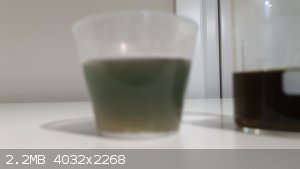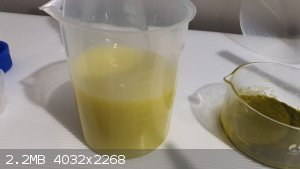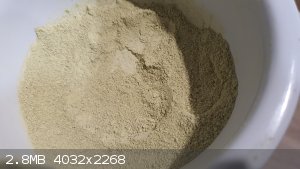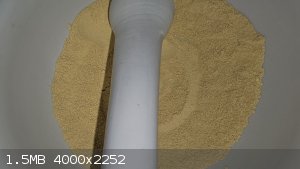| Pages:
1
2 |
KoiosPhoebus
Hazard to Self
 
Posts: 53
Registered: 23-1-2023
Member Is Offline
|
|
Preparing soluble metal citrates
Citric acid is a widely available, weak organic acid capable of chelating most
multivalent metals. This occurs due to its three carboxyl groups which are negatively-charged when deprotonated (diagram from Zabistak et al, 2018):

In addition to being widely available, citric acid is also relatively safe, biodegradable, and one of the stronger naturally-occurring chelators (Table of four organic acid complex stability constants, Resource on stability constants of chelators used in food, Stability constants of some other organic acids). Metal citrates, however, are not nearly as common as, say, metal gluconates, due to their
insolubility. One reason is that citric acid is a triprotic acid, meaning that when a divalent metal hydroxide is reacted with citric acid, a
polymeric structure is formed with the formula Metal3(Citrate)2 (see row a in the image above). This structure is typically
insoluble and precipitates out of solution - which means that adding stoichiometrically equal amounts of the divalent metal and citric acid doesn't
work:
3 Metal(OH)2 + 3 HOC(COOH)(CH2COOH)2 = Metal3(HOC(COO)(CH2COO)2)2 ↓ +
HOC(COOH)(CH2COOH)2 + 6 H2O
(The equation above is heavily simplified; in reality there would be a mix of citric acid, dihydrogen or hydrogen citrate ions and some of the metal
would remain in solution as either free ions or complexed)
I was interested in using a chelated form of copper as an algaecide and as a soluble fungicide for my plants. So I thought, why not try adding an
ammonia molecule to counter-balance the charge? i.e.:
Cu(OH)2 + NH3 + HOC(COOH)(CH2COOH)2 = CuNH4(HOC(COO)(CH2COO)2)
As monovalent cations are only weakly chelated by most chelators, in theory, when the copper-ammonium citrate is added to water, the ammonium ion
should dissociate and result in a negatively-charged complex which readily dissolves. I got the idea from agricultural metal chelates, where they have
extra sodium to counterbalance the 4- charge of EDTA (e.g. "iron EDTA chelate" is usually FeNaEDTA).
In an attempt to prepare copper ammonium citrate, I dissolved 9.71 g of anhydrous citric acid in about 30 mL of distilled water and used a magnetic
stirring disc to dissolve all the citric acid.
Then, I added about 4.63 mL of 20% aqueous ammonia (having checked the density before use) and let it react with the citric acid. The solution warmed
up as the acid-base reaction occurred.
After about 5 minutes, I added about 5.03 g of copper hydroxide I prepared from copper sulphate using the method mentioned in NileRed's Making copper hydroxide video. The copper hydroxide dissolved and formed a dark, blue-green complex:

Unfortunately, after some time, a precipitate formed on the sides and bottom of the beaker.

Since a significant amount of the copper appeared to remain in solution, my suspicion was that the first reaction I mentioned had occurred, and
tribasic copper citrate (Cu3(HOC(COO)(CH2COO)2)2) had precipitated. This would have resulted in an excess
of citric acid in the solution, which lowered the pH and kept the remaining citrates somewhat protonated.
In response, I added 4.63 mL of the 20% ammonia solution, twice (in a later run, I added it just once and the precipitate eventually dissolved), and
transferred it to a crystallising dish. The solution became a deep, dark blue, suggesting that some of the ammonia had complexed the copper ion.

I then boiled the solution down on a hotplate. In the run where I added 2x 4.63 mL of 20% ammonia, ammonia volatilised from the solution (causing me
to move it outside), while in the run where I added only 1x 4.63 mL of 20% ammonia, practically no ammonia volatilised. The presence of ammonia was
tested using a wet pH paper as well as checking the pH of a nearby dish of citric acid.
Once the solution had become thick, I took it off the heat and let it cool down. When it was at room temperature, I added denatured absolute ethanol,
which initially resulted in a liquid bilayer of the copper/ammonia/citrate solution at the bottom. However, with stirring and mixing using a spatula,
the copper-ammonium citrate crystallised as a blue-green solid. Interestingly, in my first run, not all of it crystallised, with a small portion
remaining as a thick blue goo despite many attempts to scratch at it.

I then filtered off the precipitate, and dried it on a hotplate at around 50 deg C. Interestingly a small amount of ammonia seems to have volatilised
at this point, but I'm not sure if it was from ammonium in the crystal structure of the copper-ammonium citrate, or from excess ammonia which had
dissolved into the ethanol etc.
The final product was about 15.45 g of a copper ammonium citrate which looked like a slightly lighter version of copper hydroxide.
 
The product is water-soluble, with no signs of any precipitation after about 5 minutes. The colour of the solution reminds me of copper gluconate;
which makes sense as both citric acid and gluconic acid coordinate to metals via -COO and -OH groups.

Additionally, at least some of the ammonia present in the copper-ammonium citrate is present as the protonated ammonium form. When I added some
potassium hydroxide to the solution above, it became a much darker blue typical of the copper-ammonia complex. The stoichiometry of the product is
unclear due to the losses of ammonia during the precipitation and drying process, but I intend to estimate the amount of copper in the compound by
precipitating it as cupric oxide.
In the future, I might do the ammonium citrates of manganese, nickel and cobalt. The only challenge is that I'm not sure if a metal carbonate will
work as well as the metal hydroxide. An initial attempt using ammonium bicarbonate instead of aqueous ammonia to prepare the initial ammonium
dihydrogen citrate resulted in green-blue precipitate that didn't dissolve even when aqueous ammonia was added. It might be the case that some
bicarbonate ions remained in solution and precipitated a copper carbonate compound. Unfortunately, some metal hydroxides are very difficult to prepare
dry/pure due to oxidation (Mn(OH)2 is an example of this, not sure about nickel or cobalt) so I'll have to try and use the carbonate for
such metals.
[Edited on 19-8-2023 by KoiosPhoebus]
[Edited on 19-8-2023 by KoiosPhoebus]
[Edited on 20-8-2023 by KoiosPhoebus]
|
|
|
Admagistr
Hazard to Others
  
Posts: 365
Registered: 4-11-2021
Location: Central Europe
Member Is Offline
Mood: The dreaming alchemist
|
|
I recently opened this thread on the Forum, it would be a good idea to merge it with yours, so that it is not here twice...It is then unnecessary and
uncluttered, when one topic on the Forum is duplicated...
|
|
|
KoiosPhoebus
Hazard to Self
 
Posts: 53
Registered: 23-1-2023
Member Is Offline
|
|
Synthesis of ferrous ammonium citrate
The next soluble metal citrate I attempted to prepare was iron(II) ammonium
citrate. Upon some research, I found the compound sodium ferrous citrate, so I decided to use a 1:2 ratio of iron to citrate, similar to sodium ferrous citrate (plus 4 ammonium cations to balance
the charge on the complex). Ferrous citrate (Fe3(Citrate)2) is prone to oxidation in air, so I thought the slight acidity
contributed by the ammonium ions would help keep it air-stable (similar to ferrous ammonium sulphate).
To minimise oxidation, I boiled about 200 mL of water to remove as much oxygen as possible. When the water cooled to about 90 deg C, I added 19.4 g of
citric acid (~0.1 mol) and stirred until it fully dissolved. The magnetic stir bar was then removed and 2.85 g of fine mesh iron powder (~ 0.05 mol)
was added. A large amount of bubbling occurred as the metallic iron reduced the H+ to H2. After some time to allow the hydrogen
gas to displace oxygen from the flask, I sealed the flask with a cap to prevent oxygen from entering and oxidising the iron(II) ions.
Fe + 2 HOC(COOH)(CH2COOH)2 = Fe(HOC(COO)(CH2COOH)2)2 + H2
I left the solution to react for about a day; when I came back, it had a dirty-green-yellow appearance:

There was some residual black powder at the bottom of the flask; however, it did not respond to any magnets I placed near it and so it's probably
carbon impurities and I assumed the reaction completed.
I then added 18.5 mL of 20% aqueous ammonia (~0.2 mol) to deprotonate the dihydrogen citrate and form ferrous ammonium citrate:
Fe(HOC(COO)(CH2COOH)2)2 + 4 NH3 =
Fe(NH4)4(HOC(COO)(CH2COO)2)2
This caused the solution to change from yellow-green to a dark yellowish brown:

This surprised me, and I was worried that the iron had been oxidised. However, when I pipetted a small amount of the solution into a concentrated
solution of sodium hydroxide, the precipitate formed was green (before gradually becoming a red-orange), which suggests to me that the iron in the
complex is still in its +2 oxidation state:

The solution retained its colour even when the impurities were filtered off with a double layer of coffee filters.

After some reading on other chelators which coordinate via hydroxyl and carboxyl groups to iron, I think this might actually be normal (google ferrous
fumarate powder, or ferrous gluconate powder for examples). The usual yellow-green of iron(II)/citric acid solutions might be due to the citric acid
being partially protonated and therefore coordinating differently.
I then placed the solution into a crystallising dish and began heating it to evaporate off the water. I added a small amount of iron powder to the
solution to avoid any oxidation of the iron(II) complex; reasoning that I could remove most of it with a magnet after. When the solution was boiled
down to about a fifth of its initial volume, I added ethanol to precipitate the ferrous ammonium complex.
When ethanol was added and the liquid was mixed with a spatula, a chocolate-brown flocculent solid initially formed. However, after some time, it
changed colour to a dark yellow-green:

The remaining ethanol/water solution was a bright yellow-green, suggesting to me that there was still some iron citrate dissolved in there:

I then dried the yellow-green precipitate and obtained a bright yellow-green solid. The solid was very hygroscopic - even when placed in a sealed
ziploc bag with a silica gel desiccant, it still caked:

(fresh iron dihydrogen citrate solution on the left)
However, I'm not confident that this is ferrous tetra-ammonium bis-citrate. While I'm confident that the iron remains in its +2 oxidation state, I
suspect that some of the ammonium may have somehow reverted to ammonia and was removed by the ethanol.
This is what the product looks like, dissolved in water:

Adding excess citric acid results in a brighter yellow-green solution:

(lighting isn't exactly the same unfortunately, but I can attest to a colour change)
On the other hand, adding tri-potassium citrate changes the colour to brown, reminiscent of other ferrous complexes:

Fully-deprotonated citrate ions are stronger chelators than protonated citrate (data for Fe(III): https://www.researchgate.net/figure/Stability-Constants-for-... data for Cu(II): https://www.researchgate.net/figure/Stability-constants-of-c...) and so they can displace protonated citrate species from the complex. I suspect
this might be what caused the colour change.
There's also the possibility that the iron in the complex may actually have oxidised at some point, but exposure to light resulted in a redox reaction
between oxidised iron(III) and the citrate, resulting in iron(II) acetonedicarboxylate. My current plan is to repeat the procedure but with the more
basic potassium instead of ammonium, and see what happens.
|
|
|
Texium
|
Threads Merged
14-9-2023 at 14:51 |
KoiosPhoebus
Hazard to Self
 
Posts: 53
Registered: 23-1-2023
Member Is Offline
|
|
Synthesis of tetrapotassium ferrous citrate
Similar to my above attempt at preparing ferrous ammonium citrate, I first boiled
200 mL of water, waited for it to cool down to 90 deg C, and then dissolved 19.4 g of citric acid (~0.1 mol) into the solution followed by the
addition of 2.85 g of iron powder (~0.05 mol).
Once the effervescence was complete, and any remaining particles no longer responded to a magnetic field, I dissolved 12.47 g of 90% potassium
hydroxide into 50 mL of water and added that into the flask. The reaction being:
Fe + 2 HOC(COOH)(CH2COOH)2 = Fe(HOC(COO)(CH2COOH)2)2 + H2 ↑
Fe(HOC(COO)(CH2COOH)2)2 + 4 KOH = K4Fe(HOC(COO)(CH2COO)2)2 + 4
H2O
(Note that it's preferable to pre-dissolve any bases before adding them to solutions with ferrous iron; my experience is that adding solid potassium
hydroxide to such solutions results in the formation of iron hydroxide around the pellet/flake which then oxidises to give ferric iron)
The resulting solution was a very dark yellow/green:

I left it in an amber vacuum desiccator with calcium chloride for about a couple of days; however after taking it out, I saw no change in the solution
volume. Hence, I added ethanol as per the previous procedure to precipitate the complex. Unlike ferrous ammonium citrate, however, the potassium
ferrous citrate complex merely formed a liquid bilayer:

Repeated mixing with a spatula and leaving it alone for a day did not result in any crystallisation; hence I decanted as much of the ethanol as
possible. Interestingly, the ethanol is slightly orange, which suggests the possibility that ferric iron or a ferric complex dissolved into the
ethanol.


(a few dark green droplets of the water/complex layer can be seen at the bottom)
I then boiled the complex down on a hotplate with added metallic iron as a reducing agent. At first, I got a dark, olive-green solid which then became
a pale yellow-green upon further drying:

Comparing the tetrapotassium ferrous citrate (on right) to the previously prepared ferrous ammonium citrate (left):

Similar to the ferrous ammonium citrate, a dilute solution of the complex is a dark yellow-green:

Due to the colour difference vs freshly prepared potassium ferrous citrate, I'm not 100% certain as to the stochiometry or even if the compound is a
citrate. It might be the case that the iron(II) ion was oxidised by air to iron(III), and was then reduced by citrate back to iron(II) with the
citrate being oxidised to beta-ketoglutarate. I will note that the ferrous ammonium citrate and potassium ferrous citrate both resemble pictures of
sodium ferrous citrate (see here and here). However, in my experience, industrial producers of such supplements tend to be good at guaranteeing the amount of the supplemented nutrient
e.g. iron (and if you have a really good manufacturer, the amount of iron(II) or iron(III)), but not necessarily other factors such as whether the
citrate is oxidised. Hence, I'm not sure if these pictures are a good comparison.
|
|
|
KoiosPhoebus
Hazard to Self
 
Posts: 53
Registered: 23-1-2023
Member Is Offline
|
|
Recently, I found out that my ">90% potassium hydroxide" is actually closer to
being 87-88% by acidimetry. Hence, I decided to repeat this synthesis with a slightly higher mass of potassium hydroxide (basically using 56.106 g/mol
÷ 0.88 as my "molar mass").
Interestingly, while the colour of the final solution remained very similar (a very dark yellow-green), the precipitate obtained by mixing with
ethanol was instead a somewhat-pale yellow in colour:

Placing the new potassium ferrous citrate next to the previous batches (old on left, new on right):
 
This makes me wonder if the previous batch was stoichiometrically deficient in potassium, and mixing the solution with ethanol resulted in a product
with at least one mono-protonated citrate. It would be an explanation for why the solution changed colour upon being mixed with ethanol.
Another possibility is that the increased alkalinity of the solution helped to deprotonate the hydroxyl group on citric acid. While the hydroxyl group
should be difficult to ionise in aqueous solution (pKa > 11, depending on source), this publication describes a number of X-ray crystallography studies which demonstrate that citrate can coordinate metals through the hydroxyl
group. A separate review describes the downward shift of pKas on nucleobases in the presence of metals which illustrates the possibility that the
hydroxyl group is more readily ionisable in the presence of a metal which can compete with the hydrogen for binding to the oxygen.
A third possibility is that some sort of redox chemistry occurred at the higher pH. For example, maybe the iron(II) more readily oxidised to iron(III)
and was reduced by the citrate in the presence of light. This would have resulted in the formation of 3-oxoglutarate which may have resulted in a
different coloured complex. I should add here that adding the new potassium ferrous citrate to sodium carbonate did not result in the formation of a
dark-green precipitate like with the old potassium ferrous citrate. Instead it formed a dark yellow solution which was somewhat closer to orange when
compared to new potassium ferrous citrate solution. However, adding a few drops of hydrogen peroxide to a solution of the new potassium ferrous
citrate did cause it to go orange-red, suggesting that the iron in the complex remains at Fe2+ (i.e. oxidation of the iron is probably not
the cause of the colour difference).
Personally, I think the most likely possibility is the first. With the second, Fe2+ forms a much weaker complex with citrate than
Fe3+ (KFe(II) = 104.8 versus KFe(III) = 1011.27) and hence I doubt Fe2+ would be
able to displace the hydrogen from the hydroxyl group to ionise it for complexation. While the third is also plausible, the colour of the new and old
potassium ferrous citrate solutions appear very similar prior to the addition of ethanol, meaning that the oxidation state should not be significantly
different between both samples (the only possibility is a redox reaction upon addition of ethanol). Additionally, I do add a small amount of metallic
iron when boiling the solutions down and hence the complexed iron should not oxidise that readily.
|
|
|
| Pages:
1
2 |
|